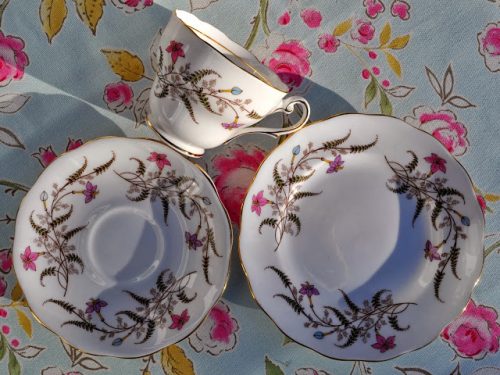My mother hated her wedding dishes. These dishes, of fine china with a lavender floral pattern numbered E2904 from Henry Birks and Sons department store, had been given to her by her family when, at twenty years old, she had married my father. She never used them. She would say to me, it’s a set of eighteen and you will each have a set of six, you and your sisters, when I die. My mother never did explain how the single coffee pot, teapot, casserole dish and the salt and pepper shakers would be divided by three.
I grew up with the silent weight of these unused dishes, dishes I never saw until I was in my teens. When I left home to my first apartment, I asked my mom, can I have my dishes. I need some for my new place.
She pursed her lips and pulled in her chin, no, you’ll break them.
My mom didn’t like them and I didn’t particularly like the pattern or colour either. Nor did my sisters. Occasionally I would ask her, why don’t you like the dishes and my mother would say, I’ll talk about it later, which in our family meant never. And periodically over the years, I would ask if I could have my dishes and my mother would scrunch her lip and say, you’ll break them and then you won’t have them.
I’ll never break them because I’ll never have them, I thought.
When my mother did die, nobody in the family wanted the dishes. They are so ongepotchked, one sister said and the other, I don’t like all those purply flowers and vines. Thus I inherited two large and heavy boxes of unwanted dishes which I stored for over fifteen years.
Recently I decided to look at them, thinking maybe now I would like the colour and design. And I wondered why my mother had disliked the dishes and I equally wondered why I had not insisted that she tell me.
The two boxes of dishes sat on a shelf in my shed that could only be accessed by ladder. At the top of a ten foot ladder, I reached overhead to take the first box, planning to pull it down to my chest. I held the box over my head and before I could begin my descent, the weight of the box unbalanced me and the ladder. Poised in the moment, and in the air, I wondered about the justice of having my back sprained, twisted or broken by a heirloom gift that was unused and had caused mental discomfort to my mother for over sixty years. I continued in a graceful arc backward and I thought, it’s me or the dishes. As my body unwillingly followed the box in a parabolic curve, at the peak of the crest, adrenaline rushed up from my toes into my arms and I clutched the box back into my upper body and restored my balance. The ladder thunked back onto the wall and I breathed, heavily, with a bruised chest, but I breathed.
After my neighbour’s seventeen year old son took down the second box, I opened them. The eighteen piece set was incomplete and tinted with newspaper ink. The teapot was missing the lid, the sugar bowl was cracked. The teacups did not have enough saucers and who uses teacups with handles in which you can barely insert your pinky. The dinner, bread and dessert plates now numbered twelve, eleven and six. The colours were faded and jaundiced and the pattern as strangely busy and yet as bland as I had remembered it.
I repacked the dishes and stored the boxes on the shed floor under a shelf.









